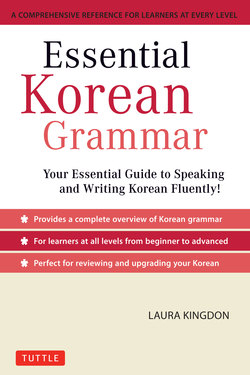Читать книгу Essential Korean Grammar - Laura Kingdon - Страница 8
На сайте Литреса книга снята с продажи.
ОглавлениеHow to Use This Book
When I first started studying Korean, I found there were any number of books, blogs, podcasts, classes, etc., available for beginners, and I rejoiced. However, as my studies progressed, the quantity of appropriate materials dropped sharply and while there were still many textbooks, very few of them explained the material in a useful way: for instance, though they would happily explain that 어서 eoseo and 으니까 eunikka both roughly meant “so,” there was little guidance as to when it was appropriate to use each form. These books also tended to be poorly organized, with ㄴ다고 해서 dago haeseo in one chapter, ㄴ다고 하니까 dago hanikka several chapters later and ㄴ다고 하는데 n dago haneunde a few chapters again after, even though these are all very similar expressions.
In this book, I have attempted to synthesize all the information gained from my studies into a format that’s useful and convenient for others to follow. I am not planning to teach you these expressions for the first time but rather to provide a useful guide to help you make sense of what you’ve already partially learned and to help you use these expressions more fluently, much like a toolbox to help you form correct and natural-sounding Korean sentences rather than ending every single sentence with the same old 아/어/여요 a/eo/yeoyo.
To this end, I have mainly focused on verbs and adverbs. Constructing Korean sentences is really all about what you do with the verbs, and a whole lot of implications are packed into different verb endings. There’s a little about pronouns because contractions are used all the time (just like in English) but rarely taught, and then some information about adverbs at the end because a good adverb can really spice up a sentence (and because I myself find them confusing at times and so I suspect others might as well).
I really haven’t focused on vocabulary since you can probably use a dictionary just as well as I can. There are some good vocabulary books listed in the Appendix if you want a little more direction.
There are only a few different ways to attach verbs and endings in Korean and I have summarized these on page 19, which you can refer back to anytime. Each expression comes with its own set of “hooks.” For example, every expression starting with “ㄴ/는” attaches to verbs the same way: ㄴ to verbs ending in vowels and 는 to verbs ending in consonants, regardless of tense or any other factor. This seems daunting at first, but with practice it will become second nature.
Because this book is intended to take you from beginning to advanced Korean, I recognize that my readers will be at somewhat different levels and will know or not know different things, so I’ve summarized what I consider to be the basic points of Korean grammar in “The Basics of Korean” for you to check if you need a little help. I haven’t spent much time on them because it’s not terribly difficult to find good-quality materials on basic Korean grammar. If you find you’re not quite ready for this book yet, I’ve listed some useful beginning Korean books in the Appendix.
I have also tried to keep the language in my examples fairly simple. When possible, they all end in the 아/어/여요 (polite) form because those are the most useful and I wanted to keep everything consistent for the sake of clarity. Unless I say otherwise, you can use any of these expressions with any level of politeness.
